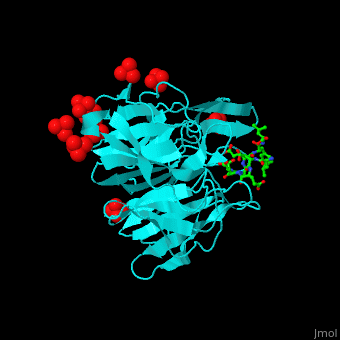Kelch-like protein
From Proteopedia
(Difference between revisions)
| Line 1: | Line 1: | ||
<StructureSection load='1x2r' size='450' side='right' caption='Human Kelch-like protein 1 (Keap1) Kelch domain (cyan) complex with NRF2 Neh2 peptide (green) and sulfate (PDB code [[1x2r]])' scene='70/706701/Cv/1'> | <StructureSection load='1x2r' size='450' side='right' caption='Human Kelch-like protein 1 (Keap1) Kelch domain (cyan) complex with NRF2 Neh2 peptide (green) and sulfate (PDB code [[1x2r]])' scene='70/706701/Cv/1'> | ||
== Function == | == Function == | ||
| - | '''Kelch-like proteins''' (KLHL) contain multiple Kelch motifs. This motif is about 50 residues long and forms a four-stranded β-sheet blade. Six to eight such blades form a circular β-propeller domain. β-propellers are involved in protein-protein interactions. The N-terminal of KLHL contains other protein domains like BTB (Broad-Tramtrack-Bric-a-brac) which is also involved in protein-protein interactions<ref>PMID:23676014</ref>.<br /> | + | '''Kelch-like proteins''' (KLHL) contain multiple Kelch motifs. This motif is about 50 residues long and forms a four-stranded β-sheet blade. <scene name='70/706701/Cv/2'>Six to eight such blades form a circular β-propeller domain</scene>. β-propellers are involved in protein-protein interactions. The N-terminal of KLHL contains other protein domains like BTB (Broad-Tramtrack-Bric-a-brac) which is also involved in protein-protein interactions<ref>PMID:23676014</ref>.<br /> |
*'''KLHL1''' may play a role in organizing the actin cytoskeleton in brain cells.<br /> | *'''KLHL1''' may play a role in organizing the actin cytoskeleton in brain cells.<br /> | ||
*'''KLHL2''' '''KLHL11''' is a component of the cullin-RING based E3 ubiquitin-protein ligase system.<br /> | *'''KLHL2''' '''KLHL11''' is a component of the cullin-RING based E3 ubiquitin-protein ligase system.<br /> | ||
Revision as of 10:58, 14 April 2016
| |||||||||||
3D Structures of Kelch-like protein
Updated on 14-April-2016
References
- ↑ Dhanoa BS, Cogliati T, Satish AG, Bruford EA, Friedman JS. Update on the Kelch-like (KLHL) gene family. Hum Genomics. 2013 May 15;7:13. doi: 10.1186/1479-7364-7-13. PMID:23676014 doi:http://dx.doi.org/10.1186/1479-7364-7-13
- ↑ Padmanabhan B, Tong KI, Ohta T, Nakamura Y, Scharlock M, Ohtsuji M, Kang MI, Kobayashi A, Yokoyama S, Yamamoto M. Structural basis for defects of Keap1 activity provoked by its point mutations in lung cancer. Mol Cell. 2006 Mar 3;21(5):689-700. PMID:16507366 doi:10.1016/j.molcel.2006.01.013

